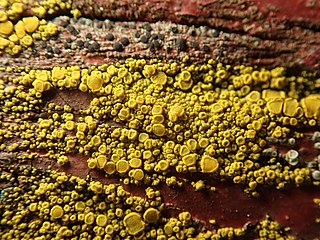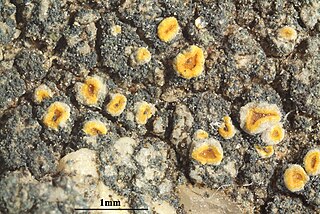
Candelariella is a genus of bright yellow, ocher, or greenish yellow crustose or squamulose lichens in the family Candelariaceae. Members of the genus are commonly called eggyolk lichens, goldspeck lichens, or yolk lichens. The genus was circumscribed in 1894 by Swiss lichenologist Johannes Müller Argoviensis, with Candelariella vitellina assigned as the type species.
Caloplaca durietzii, or Durietz's orange lichen, a smooth surfaced yellowish orange crustose areolate lichen with elongated lobes that grows on wood or bark in southwestern North America. It is commonly seen growing on old junipers in Joshua Tree National Monument in the Mojave Desert. It is in the Caloplaca fungus genus of the Teloschistaceae family.
Apatoplaca is a fungal genus in the family Teloschistaceae. It is monotypic, containing a single species, the rare crustose lichen Apatoplaca oblongula, found in the United States.
Candelariella clarkiae is a rare species of crustose lichen in the family Candelariaceae. It was discovered in Colorado, USA, and formally described as a new species in 2015 by lichenologists Erin Tripp and James Lendemer. It was originally published with the species epithet clarki, but this was subsequently corrected to clarkiae. The name honors Dina Clark, Collections Manager at the University of Colorado herbarium, for her significant contributions to the knowledge of the Colorado flora, particularly the high plains ecosystems flanking the Southern Rocky Mountains. The authors note of the lichen that "it is bright and sunny, just like Dina’s disposition".
Lecidea hoganii is a rare species of saxicolous (rock-dwelling), crustose lichen in the family Lecideaceae. It is known to occur only in Boulder, Colorado, where it grows in association with other lichens in mixed saxicolous communities on sandstone in the Fox Hills Formation. The lichen is characterized by its thick white, chalky thallus, sessile to raised apothecia, presence of a dark pink pigment in the hymenium, and absence of secondary compounds.
Cinnabaria is a monospecific fungal genus in the family Teloschistaceae, represented by its sole species, Cinnabaria boliviana. This lichen, found only in Bolivia, is distinguished by its unique genetic signature, as well as morphological characteristics like ascospore size and other traits. Despite its resemblance to certain species from the Caloplaca cinnabarina species complex, Cinnabaria boliviana belongs to a distinct genetic lineage.
Solitaria is a fungal genus in the family Teloschistaceae. It contains a single species, the corticolous (bark-dwelling), crustose lichen Solitaria chrysophthalma.
Caloplaca cupulifera is a widely distributed species of saxicolous (rock-dwelling), crustose lichen in the family Teloschistaceae. It has a chrome-yellow thallus with bright yellow cup-shaped soredia. Although originally described as a new species in 1915 and placed in the large genus Caloplaca in 1931, modern molecular phylogenetics suggests that its classification requires an update.
Caloplaca astonii is a rare species of crustose lichen in the family Teloschistaceae. Described in 2007, is known for its distinct appearance and very limited distribution in Australia. The lichen has a thin thallus measuring 3–8 mm wide, with confluent spots that are thicker and cracked in the centre, showing a dull rose-orange or dull brown-orange colour, and lecanorine apothecia that transition from being immersed in the thallus to raised above it, revealing a bright reddish-brown disc.
Caloplaca conranii is a species of saxicolous (rock-dwelling), crustose lichen in the family Teloschistaceae. The lichen has a bright yellow thallus about 1–2 cm wide, featuring a thick texture with convex, pustule-like formations around the edges and occasionally forming clusters in the centre. Its apothecia are quite large and heavy, ranging from 0.4 to 1.5 mm in diameter, with a flat, dull orange or brownish-orange disc, and long, narrow ascospores.
Caloplaca haematommona is a little-known species of corticolous (bark-dwelling), lichen in the family Teloschistaceae. It has a very thin, whitish, crust-like thallus dotted with black, spanning about 10–18 mm in width, and apothecia ranging from 0.2 to 0.8 mm in diameter, and becoming yellow-orange to brownish-orange as they mature. The lichen is known only from its type locality in Western Australia.
Elixjohnia gallowayi is a species of saxicolous (rock-dwelling), crustose lichen in the family Teloschistaceae. It has a vividly coloured thallus, ranging in hues from bright red to reddish-orange. It is found in Australia.
Neobrownliella montisfracti is a species of saxicolous (rock-dwelling), crustose lichen in the family Teloschistaceae. It is found in Australia. The small lichen has dull pink to grey areoles, characterised by completely immersed, reddish to pink-brown apothecia and lacking soredia and isidia. Its areoles are closely pressed against the substrate, with the apothecia containing small, elongated ascospores and narrowly rod-shaped conidia.
Caloplaca letrouitioides is a little-known species of corticolous (bark-dwelling), crustose lichen belonging to the family Teloschistaceae, described in 2011. It is known to occur in Victoria, Australia. The species was named for its superficial resemblance to species in the genus Letrouitia. The anatomical characteristics of Caloplaca letrouitioides, particularly the well-developed true exciple and the unexpanded paraphyses tips, along with the absence of algae in the apothecia, set it apart from other species in the genus.
Caloplaca patagoniensis is a species of lignicolous (wood-dwelling), crustose lichen in the family Teloschistaceae. It is found in Chile. It forms small thallus patches, with distinctive areoles that change from whitish or greyish-yellow to deep orange or brownish-orange, often covered by a bright orange blastidious mass. Its fruiting bodies (apothecia) are dark reddish-orange and initially immersed in the substrate, while its spores are ellipsoid to elongated, and the species contains parietin, turning purple when exposed to a potassium hydroxide solution.

Flavoplaca maritima is a species of crustose lichen in the family Teloschistaceae. It is found in costal areas of Northern, Western, and Southern Europe. It mostly occurs on rocks, but has also been recorded growing on wood.
Flavoplaca kantvilasii is a species of saxicolous (rock-dwelling), crustose lichen in the family Teloschistaceae. Found in Australia, it was formally described as a new species in 2007.

Kuettlingeria soralifera is a saxicolous (rock-dwelling), crustose lichen species in the family Teloschistaceae, first described in 2006. It is similar to Kuettlingeria xerica but distinguished by the presence of soredia on its thallus.

Gyalolechia fulgens, the scrambled egg lichen, is a species of terricolous (ground-dwelling), squamulose lichen in the family Teloschistaceae. The lichen comprises overlapping, slightly pruinose lemon-yellow scales with a lobed margin. It grows on highly calcareous substrates such as chalk, limestone and shell sand, often in association with the moss species Trichostomum crispulum.
Elenkiniana is a genus of lichen-forming fungi in the family Teloschistaceae. It has three species, all of which occur in Eurasia.



